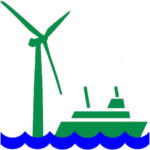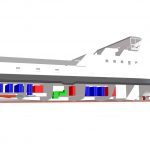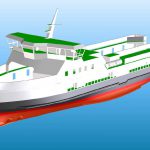With EU-funding granted for a ferry running solely
on battery power, the Danish Green Ferry Vision project
is becoming reality.
The contract for the construction of the world’s first car and passenger ferry that is 100% electrically powered was awarded[ds_preview] to Søby Shipyard of Denmark. Expected to be operational by 2017, the ferry will service the route between the Danish mainland and Aeroe Island, carrying 130 passengers and 40 cars.
Since the electricity for the battery packs is coming from wind farms, the ship is a real zero emissions solution. Compared to a conventional ferryboat it will save up to 2,000t of CO2 per year. The two battery packs will together provide a total power of 4.2 MW for the electric motors. The ships maximum speed will be 15.5kn.
The cost of the newbuilding is expected to be about 30% higher than for a conventional vessel. Also about 15% more money is needed for special land installations such as recharging stations. But according to the Green Ferry Vision project, operational costs will be reduced by 15–20% compared to the ferry currently in use.
Because weight is always an issue for electrically powered ships – the two battery packs will add an extra 51t – light weight materials will be used in the superstructure. Danish company Tuco Marine will supply these carbon composite components.
The electric drive train will be delivered by Finnish specialist Visedo, who was able to replace a big German technology company as partner in the project. The company already raised attention through several super yacht projects, smaller ferries such as the Gothenburg river crossing ferries and most recently with an LNG-hybrid tanker vessel, the Damen Eco-Liner.
In partnership with Swiss battery manufacturer Leclanché, Visedo will also provide the lithium-ion batteries and the energy management system. As Visedo sales manager Tomi Ristimäki explains, the battery lifespan ist ten to twelve years. »The battery pack is capable of meeting a full working day of the vessel.« The charging station is only in one shore in the ship’s operation route and is also part of Visedo’s delivery while the municipiality of Ærø is responsible for the electrical network.
According to the project consortium, the zero emission ferry will allow for almost no engine room, total redundancy, high fire safety, higher speed, little maintenance and less crew requirements making its operation extremely cost efficient. Ristimäki: »Our electrical propulsion system has more redundancy options than conventional solutions. The system can be designed to operate also with partial system and also the backup solutions are more flexible.«
A special hull form will reduce wake waves behind the ferry by 60–70% and thereby enable it to operate in shallow water of protected areas. »The ship is designed with extremely low water resistance which is significantly increasing energy efficiency weight reductions«, the sales manager explains. The silent propulsion system is also more environmentally friendly. The project will get funding from the EU’s 21mill. € EU Horizon 2020 initiative.
Felix Selzer






















